Scope creep: Greater scope = more benefit?
The company is growing, it generates more customers, the mass of projects and their scope is increasing, and therefore a good deal of money is flowing into the till. Isn't that every manager's dream? Sure! Well, as long as he keeps the projects under control.
But they do exist. Periods in which projects get completely out of hand. The project managers add one requirement after the other without paying enough attention to the overall scope of the project. After all, more scope means more benefits and thus more success. Doesn't it? Yes and no!
The truth is: an arbitrary expansion of the scope can destroy any project.
What are scope creeps and why are they so dangerous?
Let's assume we have a project with a time frame of 6 months, a budget of 230,000 Euros and 100 requirements that need to be met.
Do you think you could change one component without affecting the other two? Then you are wrong. It's a simple calculation: if the scope increases, more time is needed; or even more employees. Both require an upward budget adjustment. But as long as we don't get more out of this adjustment - in the form of increased sales, for example - the additional requirements become useless and thus a massive threat to the success of the project.
Above, we have listed three components by which project management is defined - three things that are defined for each project and ... which inevitably influence each other. These three things are also called the Magic Triangle.
As you can imagine, a scope creep can lead to a fatal loss of control and thus to a massive threat to the project. And this danger is by far not as small as one would like to assume: The Pulse of the Profession survey 2018 by PMI reveals that a scope creep has occurred in more than 52% of projects.
The most common scope creep triggers
Inadequately defined project scope
Determining the right project scope is crucial for the success of a project. Similarly, the lack of a set framework can cause the entire project to fail. In the course of the project, the participants will then behave like hungry grocery shoppers in a supermarket without a shopping list. We need all that! Don't we?
Too little research
The absence of an exact plan with a worked out project scope is usually due mainly to a lack of research. Anyone who underestimates financial, HR and time resources and puts too little effort into the requirements analysis will quickly find himself on thin ice. If it then turns out that the requirements from the customer's point of view do not correspond to what was defined, the ice field cracks faster than one is able to react.
The requirements analysis should be carried out in several steps in order to obtain a catalogue of requirements that is as precise as possible:
- Analysis of the scope: The cornerstone of the project is based on a thorough collection of information on the requirements that the final product should ultimately meet.
- Specification: In a further step, you should consider what an implementation of the requirements would involve and what problems might arise.
- Detailed planning: Last, the fine tuning of the plan follows. The requirements are classified according to their feasibility and relevance and then put into a time context.
.
Lack of understanding and monitoring the project
It is crucial to understand what the project is about and what the final results will be. This is the only way the final product will meet the requirements later on. So anyone who starts work even though the research is not yet complete and who is unable to distinguish the important from the unimportant, has probably done the job in vain.
Monitoring during the entire course of the project is not optional - it is a must. Project managers should constantly keep an eye on whether all requirements are being implemented correctly and whether there are bottlenecks and internal problems.
Lack of scope creep prevention processes
Of course, even a well thought-out project plan is not infallible and requirements, which certainly have their raison d'être, may come to light later. In reality, of course, the scope of the project is still being fine-tuned later on. However, here too, it is important to bear in mind: Every small expansion is an expansion after all. Therefore, processes must be established for cases like this: that changes must be examined with regard to their benefit and relevance compared to other requirements and approved by several decision-makers.
Too little experience
Scope creeps are usually created in unexperienced teams. Problems arise for example when:
- it is difficult for employees to refuse customer requests
- project managers are not able to reject new requirements
- End users whose usage behaviour determines the requirements portfolio, are consulted too late or are not considered at all
- etc.
The project manager and the team members must be able to identify these situations as danger spots for scope creeps and learn to distinguish important requirements from nice-to-have requirements.
Communication deficits
We cannot mention often enough that bad communication is a major reason for failing projects. Consider what happens as soon as requirements are recorded without documenting them. And what happens as soon as the team adds an overload of new requirements is recorded just because the team does not communicate that it is already overloaded? Well, most likely nothing good.
How to avoid scope creeps
Guarantee clarity!
Projects must be clear: clear, crystal clear, your project! So think about what parameters need to be defined in advance and while doing so think back to past projects. Yes, it can be exhausting. But during the course of the project you will save yourself much worse headaches. Here is a first approach:
Let your customer define all expectations and requirements BEFORE the team gets started. The customer should be involved from the beginning and have a clear idea of the scope of the project. This should be set out in a contract and signed by all parties. Determine the project phases, define how the team and all stakeholders will communicate and what process will be followed if the scope increases.
Make sure to keep the stakeholders informed about the development of the project and be clear about what consequences (and costs!) are to be expected if the scope is being expanded. Make sure that your team has access to all agreements and that priorities are clearly communicated.
Observe processes!
One of the top rules that every team member should internalize: No project changes without consultation! This is where communication comes into play as one of the most important aspects of any project. Once you have created a change management plan, you will know exactly who to consult and which factors to check. The lack of such a strategy makes the project a bottomless pit.
Capture changes!
If a new requirement is actually included, a renewed look at the change management plan reveals how the changes are communicated to the team and integrated into the project plan. Every single change should be recorded, even if it is just to have an overview of the extent to which the project scope has been exceeded. This information is also extremely important for the team, since the change can influence the execution of other requirements.
Do not walk into the Gold-Plating trap!
There are cases in which project teams show a certain kind of overzealousness, which is far from being positive. They conduct so-called gold-plating. In fact, additional requirements are well-intentioned but unfortunately they miss the point unless they are discussed with the client or another authorized people. No one else should judge the usefulness of a new requirement. Additional functions/features may well involve additional effort for the client and a greater product scope for the end user, which he or she may even find irritating. But what "product gilding" definitely entails is an increasing scope and thus an increased scope-creep risk.
Note: Of course not every idea for new requirements coming from the project team falls into this category. After all, the developers are experts. Suggesting changes that would benefit the end product makes a lot of sense. Rejecting them fundamentally would be what is commonly referred to as a "scope kill". However, it is important to have changes approved. The change management plan provides the guidelines for this.
Pay attention to communication!
Communication is the basis for good collaboration - in all areas of work. All questions and problems, all ideas and remarks as well as all key data, obligations and deadlines in connection with the project should be communicated via a specific communication channel. If a communication problem occurs, a scope creep is probably only one of the harmful consequences.
Depending on the scope of the project, a simple collaboration tool or comprehensive project management software, in which tasks, files and deadlines can be managed, developments can be tracked and discussions can be held, is suitable for this purpose.
Stackfield: Project management software for scope creep fighters:
Use the functional pages in Stackfield to set your project goals and the annotation function to discuss individual content directly.
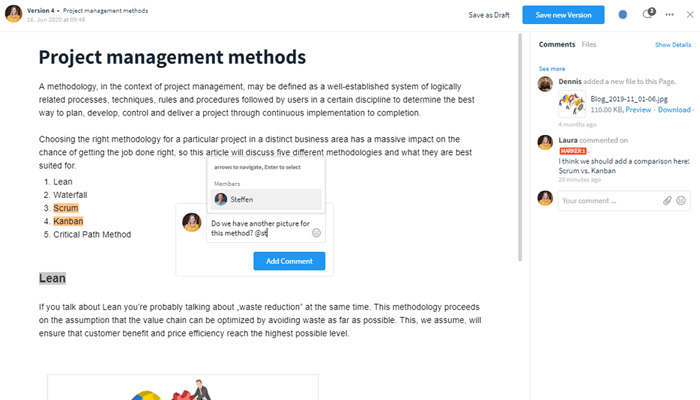
Different views for task planning (Kanban Board, Lists, Gantt Chart) with detailed task cards and individually customizable status options offer enough freedom to create a custom-fit workflow. For example, you can create a product backlog to create and prioritize your requirements as task cards.
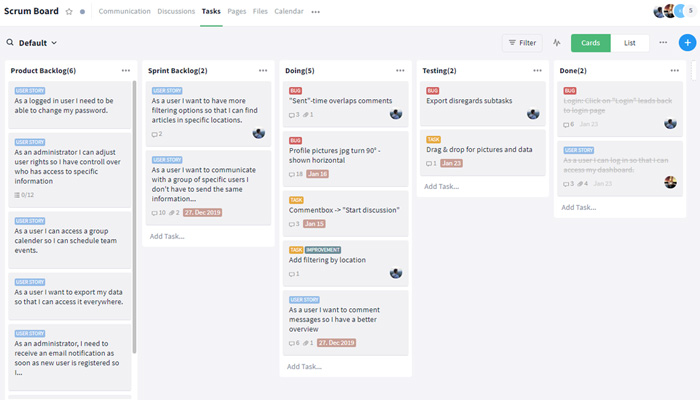
Since all functional areas within the rooms interact with each other, you can equip all elements (tasks, appointments, pages, discussions, etc.) with relevant files, which you can later access via the respective element as well as in the file module. This way all content is quickly available.
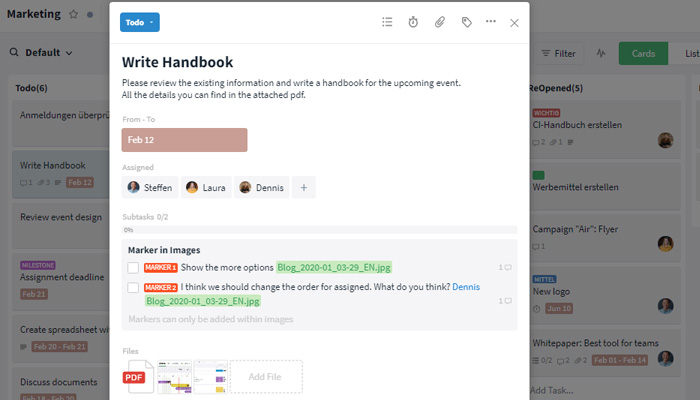
Track your progress and the impact of any requirement changes by using a Gantt Chart (timeline with task dependencies and milestones) …
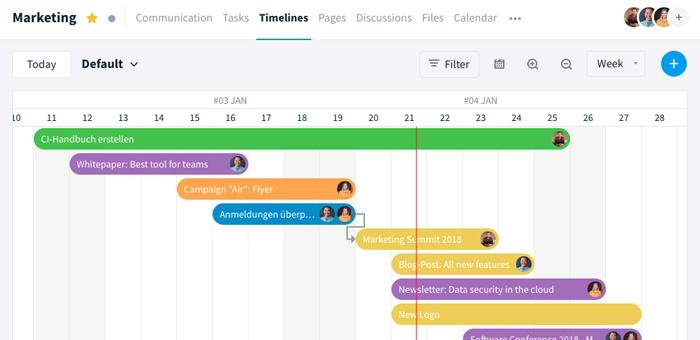
… and viewing specific project details and portfolios.
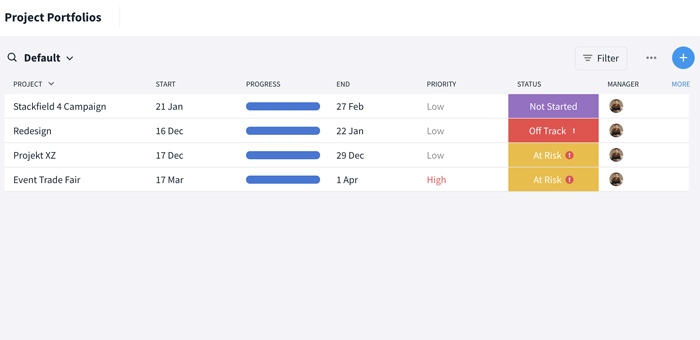
No more scope creeps
Since every project is individual and teams do not always work together in the same way, it is not always easy to avoid scope creeps. However, project managers can counter a scope creep with strategic foresight.
It is important to involve relevant stakeholders and customer requirements from the very beginning. Expectations, needs, requirements and ideas should be approved and signed by the sponsor and the project team. A well-designed change management plan provides the necessary structure to handle potential requirement changes without problems, in order to keep the project scope in line from start to finish.